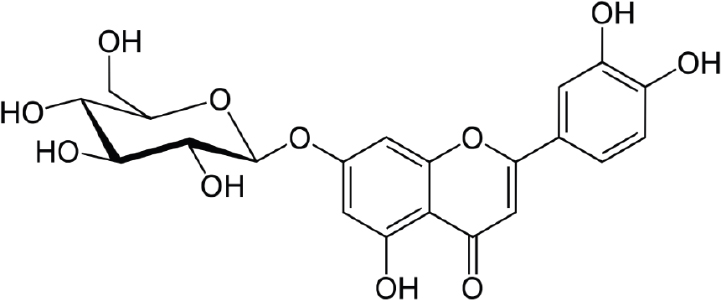
Cognitive Enhancing Activity of Cynaroside Isolated from Lysimachia christinae on Memory Impairment Insulted by Scopolamine
Abstract
The cognitive-enhancing effects of cynaroside, isolated from Lysimachia christinae, were evaluated in scopolamine-induced amnesic mice using the Morris water maze and passive avoidance tests. Cynaroside significantly improved scopolamine-induced reference memory impairment in the Morris water maze test. It also enhanced the mean escape latency, mean path length, and swimming movement. In the passive avoidance test, cynaroside significantly ameliorated scopolamine-induced amnesia, achieving approximately 70% of the level observed in normal control mice. Donepezil, an acetylcholinesterase inhibitor and widely used drug for Alzheimer’s disease treatment, served as a positive control. Cynaroside significantly inhibited acetylcholinesterase activity in the cortex and hippocampus, similar to the effects seen in mice treated with donepezil (1 mg/kg body weight, administered orally). These data suggest that cynaroside exerts potent cognitive-enhancing activity through anti-acetylcholinesterase mechanisms.
Keywords:
Cynaroside, Lysimachia christinae, Alzheimer’s disease, Cognitive enhancing activity, AcetylcholinesteraseIntroduction
Alzheimer’s disease is a progressive neurodegenerative disorder that commonly affects people over 65. It arises from neurodegeneration, marked by the accumulation of amyloid plaques, the formation of neurofibrillary tangles, inflammation, and the loss of neurons in specific areas of the forebrain. The most prominent symptom of Alzheimer’s disease is progressive memory loss, followed by a general decline in cognitive abilities.1 Although various neurotransmitter systems are impacted in Alzheimer’s disease, one significant neuropathological feature that serves as an early marker is the degeneration and functional impairment of the cholinergic system. This system, which involves neurotransmitters such as acetylcholine, plays a crucial role in cognitive functions including memory and learning. In Alzheimer’s disease, the loss of cholinergic neurons and the subsequent reduction in acetylcholine levels contribute to the characteristic symptoms of memory loss and cognitive decline. The early damage to the cholinergic system highlights its importance in the pathogenesis of Alzheimer’s disease and underscores the focus on cholinergic targets in therapeutic interventions.2 Neuronal loss in the basal forebrain, particularly in the septohippocampal acetylcholinergic systems, is a key feature of Alzheimer’s disease. Current treatments use acetylcholinesterase inhibitors to increase acetylcholine availability at synapses. Inhibitors like physostigmine, tacrine, and donepezil mitigate scopolamine’s negative effects on spatial memory in behavioral tests.3–5 Scopolamine, a muscarinic antagonist that blocks central cholinergic function, is known to induce reversible cognitive impairment. It specifically affects attention maintenance, information processing, and the acquisition of new knowledge in both rodents and humans.6–9 These impairments closely resemble the memory disturbances observed in Alzheimer’s disease. As a result, the scopolamine-induced amnesic mouse model has become a widely used experimental tool for studying Alzheimer’s disease, providing valuable insights into its underlying mechanisms and potential therapeutic strategies.10,11
In our previous research, we explored the neuroprotective effects of cynaroside, a prominent bioactive compound found in Lysimachia christinae. Specifically, cynaroside was investigated for its ability to protect against neurotoxicity induced by glutamate in HT-22 cells, a neuronal cell line commonly used in such studies. Our findings revealed that cynaroside exerts significant antioxidative effects. It effectively reduced the overproduction of intracellular calcium ions (Ca2+) and cellular peroxide levels in neurons that were damaged by exposure to glutamate. Moreover, cynaroside demonstrated the capability to mitigate the decrease in glutathione (GSH) content, a crucial antioxidant defense in cells, and it also helped in attenuating the excessive buildup of intracellular calcium and cellular peroxide in cultured cortical neurons subjected to glutamate-induced injury.12 Building on these promising results, our subsequent investigation aimed to assess whether cynaroside could mitigate memory deficits induced by scopolamine in mice. We employed two well-established behavioral tests: the passive avoidance test and the Morris water maze test. These tests are widely used to evaluate cognitive functions such as learning and memory in experimental animals.
Furthermore, to better understand the potential mechanisms underlying cynaroside’s effects on cognition, we examined its impact on acetylcholinesterase activity in the cortex and hippocampus of mice treated with scopolamine. Acetylcholinesterase inhibitors are known to enhance cholinergic transmission in the brain, which can improve cognitive function, especially in conditions involving cholinergic deficits like Alzheimer’s disease. Overall, our study aimed to elucidate the cognitive-enhancing properties of cynaroside and explore its therapeutic potential in conditions associated with memory impairment, potentially paving the way for novel treatment strategies in neurodegenerative diseases and other cognitive disorders.
Experimental
Experimental animals – In this study, ICR mice were used to evaluate cognitive enhancement activity. Four-week-old male ICR mice, each weighing approximately 25 g, were obtained from Kangwon Life Science Co. (Gangwon Province, Korea). Upon arrival, the mice were housed at the Kangwon National University Animal Care Center, where they underwent a one-week adaptation period. Throughout the adaptation period, the animal room was maintained under controlled conditions: the temperature was kept at 23 ± 1oC, the humidity level was maintained at 60%, and the mice were subjected to a 12 hour light-dark cycle. The mice had unrestricted access to both food and water during this period. All procedures involving the mice, including their housing, care, and use in experiments, were conducted in compliance with the Kangwon National University Animal Care and Use Guidelines (IACUC, KIACUC, 06/2021). Furthermore, the experimental protocols adhered to the ARRIVE guidelines, ensuring that the study met high standards for the ethical treatment and reporting of animal research.
Compounds or drugs – Cynaroside was isolated from the whole plants of L. christinae. The total methanolic extract of L. christinae and its n-hexane, chloroform, ethyl acetate, and n-butanol fractions were prepared following a previously described procedure.13 Cynaroside was specifically isolated from the n-butanol fraction and identified through spectral analysis. Scopolamine, with a purity exceeding 98%, as well as phosphate-buffered saline (PBS) and carboxymethyl cellulose (CMC), were sourced from Sigma (St. Louis, MO, USA). Scopolamine was used to induce Alzheimer’s-type dementia by increasing acetylcholinesterase activity. Donepezil, with a purity exceeding 95%, was obtained from Samjin Pharmaceutical Co., Ltd. (Seoul, Korea). Donepezil inhibits acetylcholinesterase, preventing the degradation of acetylcholine, thereby maintaining a high concentration of acetylcholine in neuronal cells. As a result, donepezil is typically used to enhance memory and cognitive function. Scopolamine was utilized in the study due to its well-known mechanism of inducing cognitive deficits similar to those observed in Alzheimer’s disease. By increasing acetylcholinesterase activity, scopolamine decreases the levels of acetylcholine in the brain, thereby impairing memory and cognitive functions. Donepezil was included in the study as a reference drug. It is a well-established acetylcholinesterase inhibitor used in the treatment of Alzheimer’s disease. By preventing the breakdown of acetylcholine, donepezil helps to sustain higher levels of this neurotransmitter in the brain, which is crucial for maintaining cognitive functions. This action of donepezil makes it an effective therapeutic agent for enhancing memory and cognition in patients with Alzheimer’s disease.14
Drug administration – The mice were divided into six groups (n = 6): control, scopolamine, positive control (donepezil at 1 mg/kg), and three cynaroside groups (1, 5, and 10 mg/kg). Cynaroside dosages were based on in vitro data and future clinical trial considerations. No toxicity-related fatalities occurred, and post-assay organ examinations showed no abnormalities compared to the control group. Cynaroside and donepezil were given orally 90 minutes before scopolamine treatment. The control group received a 0.5% CMC solution. Scopolamine (1 mg/kg) was administered subcutaneously 30 minutes before behavioral tests. Mice were treated for four days before the Morris water maze test and once on the training day for the passive avoidance test.
Morris water maze test – The water maze test was conducted following the Morris method with some modifications. A large round pool, 90 cm in diameter and 40 cm in height, was filled with warm water (20 ± 1°C) and 500 ml of white milk. The pool was divided into four quadrants, with an escape platform placed in the center of one quadrant, positioned 1 cm below the water surface. The platform, cylindrical in shape, measured 10 cm in diameter and 26 cm in height.
A smart video-tracking system (Smart ver. 2.5.21) linked to a video camera monitored and recorded the mice’s swimming activities, including time, distance, and speed. The time taken for a mouse to find and stay on the platform was recorded as the escape latency. On the first day, mice underwent a 60-second practice session without the platform as an acquisition trial. Test trials were then conducted daily for four days. If a mouse did not find the platform within 120 seconds, the trial was terminated, and the escape latency was recorded as 120 seconds. After the experiment, the mice were euthanized via cervical dislocation.
Passive avoidance test – The passive avoidance test was conducted following our previous study with some adjustments. The apparatus consisted of two equally sized compartments (17 cm × 12 cm × 10 cm) with an electrical grid floor, connected by a guillotine door. The test comprised three distinct trials: acquisition, training, and test. During the acquisition trial, mice were placed in the light compartment and allowed to explore. After 40 s, the automatic guillotine door opened, and upon the mouse entering the dark compartment, the door closed automatically. Twenty-four hours later, the training trial commenced. Mice were placed in the light compartment, and the guillotine door opened 30 s later. Upon entering the dark compartment, the door closed, and the mice received a brief electrical shock to their feet (0.1 mA/10 g body weight for 2 s). Twenty-four hours after the training trial, the test trial was conducted. Each mouse was placed in the light compartment, and the latency time to enter the dark compartment was recorded for up to 180 s. Following the experiment, the mice were euthanized via cervical dislocation.
Acetylcholinesterase (AChE) inhibition assay – An AChE inhibition assay was conducted using a modified Ellman method. Brain tissue was extracted from the mice within 30 mins of completing either the water maze or passive avoidance test. The hippocampi were isolated and immediately homogenized in sodium phosphate buffer using a Tissue Stick (Bioneer Inc., Alameda, CA, USA). The assay mixture included 33 μL of supernatant from the hippocampal homogenates, 470 μL of phosphate buffer (pH 8.0), 167 μL of 5,5’-dithio-bis(2-nitrobenzoic acid) (DTNB) at 3 mM, and 280 μL of acetylcholine iodide (AChI) at 1 mM. AChE enzyme activity inhibition by the cynaroside was assessed by measuring the activity with a spectrophotometer (BioTek EL808, BioTek Instruments, Winooski, VT, USA) at 412 nm.
Statistics – The mean ± S.E.M. results for the Morris water maze, passive avoidance test, and Western blot experiments were recorded. Statistical analysis of all data was conducted using one-way ANOVA followed by Tukey´s post hoc test, with IBM SPSS Statistics software V26 (IBM, Armonk, NY, USA). Significance levels between experimental groups were assessed at p < 0.05, p < 0.01, and p < 0.001.
Results and Discussion
The Morris water maze test was utilized to evaluate the cognitive-enhancing effects of cynaroside, extracted from L. christinae, against scopolamine-induced memory loss (Fig. 1). The escape latency of mice in the control group significantly and consistently decreased over the four trial days, reaching 38.4 s by the fourth day. In contrast, the scopolamine-treated group showed a longer and unchanged escape latency after the first day, culminating at 118.4 s on the fourth day, thereby confirming the effective induction of memory impairment by scopolamine. The memory-enhancing activity of cynaroside was assessed over four days, with significant improvements observed in each concentration group after the third day. The latency time for the donepezil-treated group was 68.3 s on the third day, which further reduced to approximately 50.2 s by the fourth day. The cynaroside-treated groups demonstrated a dose-dependent decrease in escape latency compared to the scopolamine-treated group. At a concentration of 10 mg/kg of cynaroside, the latency time was 56.8 s, while the 5 mg/kg and 1 mg/kg cynaroside-treated groups had latency times of 75.6 s and 84.2 s, respectively (Fig. 2).
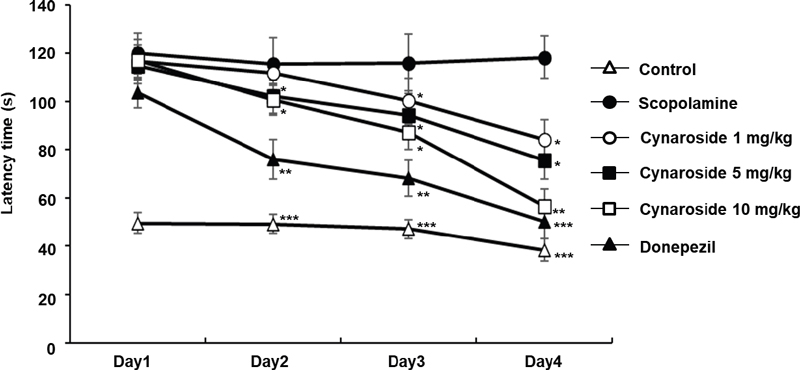
The effect of cynaroside on the spatial memory enhancement. The effect of cynaroside on the escape latency of scopolamine-treated mice in the Morris water maze test. The cynaroside (1, 5 and 10 mg/kg body weight, PO) and donepezil (1 mg/kg body weight, PO) were administered 90 min before induction of memory impairment by scopolamine. The escape latency of each group during the training-session trials is presented. Data are mean escape latencies ± SD (n = 6). (*p < 0.05, **p < 0.01 and ***p < 0.001 versus scopolamine-treated mice.)
As shown in Figure 3, the swimming distance covered by the control group was significantly shorter than that of the scopolamine-treated group. Specifically, the control group swam a distance of 432 cm, whereas the scopolamine-treated group swam 874 cm, indicating substantial memory impairment due to scopolamine. Over the course of four days, the administration of cynaroside markedly reduced the swimming distance that had been increased by scopolamine-induced memory loss. This reduction occurred in a dose-dependent manner. The groups treated with 1 mg/kg, 5 mg/kg, and 10 mg/kg of cynaroside demonstrated swimming distances of 720 cm, 563 cm, and 542 cm, respectively, showing progressive improvement with higher doses of cynaroside (Fig. 3).
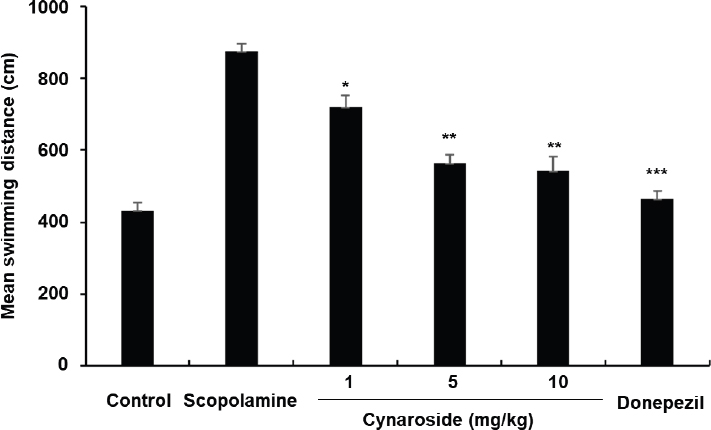
The effect of cynaroside on mean swimming distance to find the platform over 4 days of scopolamine-treated mice in the Morris water maze test. Data are mean escape latencies ± SD (n = 6). (*p < 0.05, **p < 0.01 and ***p < 0.001 versus scopolamine-treated mice.)
For the probe test, the duration that mice remained in the target quadrant, where the platform was previously located, was recorded to assess memory retention. The control group exhibited a significantly longer duration in the target quadrant compared to the scopolamine-treated group, indicating better memory performance. Specifically, the control group spent 43.6 s in the target quadrant, whereas the scopolamine-treated group only spent 14.2 s, demonstrating the memory-impairing effects of scopolamine. Treatment with cynaroside resulted in a dose-dependent increase in the time spent in the target quadrant, indicating a reversal of scopolamine-induced memory impairment. The group treated with 1 mg/kg of cynaroside spent 21.5 s in the target quadrant. Mice treated with 5 mg/kg of cynaroside spent 26.8 s in the target quadrant, while those treated with 10 mg/kg of cynaroside spent 35.1 s. These results show that higher doses of cynaroside were more effective in enhancing memory retention in the probe test (Fig. 4).
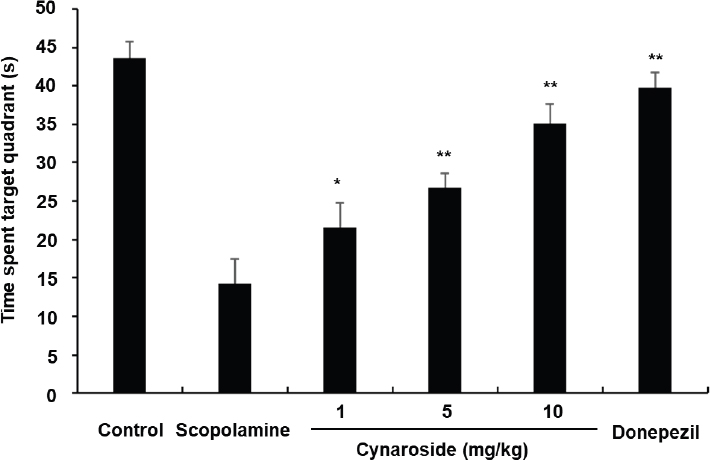
The effect of cynaroside in the probe trial. The time spent in the target quadrant during the probe trial was presented. Data are mean escape latencies ± SD (n = 6). (*p < 0.05, **p < 0.01 and ***p < 0.001 versus scopolamine-treated mice.)
The swimming speed of the mice was assessed to ensure that the observed reduction in time to locate the target platform in the cynaroside-treated group was not due to an enhancement in the mice’s motor capabilities. This assessment was crucial to distinguish between improvements in cognitive function and potential increases in physical speed. The analysis revealed no significant differences in the mean swimming speeds among the various groups: the control group, the scopolamine-treated group, the cynaroside-treated group, and the donepezil-treated group (Fig. 5). Specifically, the mean swimming speeds of the mice across these groups were comparable, indicating that motor function remained consistent regardless of the treatment administered. These findings suggest that the improvements observed in the cynaroside-treated group, as well as those in the donepezil-treated group, were not due to enhancements in locomotor activity. Instead, the effects were specifically related to the enhancement of spatial memory. This conclusion is supported by the lack of variation in swimming speed, isolating the memory-enhancing effects of scopolamine, donepezil, and cynaroside from any changes in the mice’s physical performance.
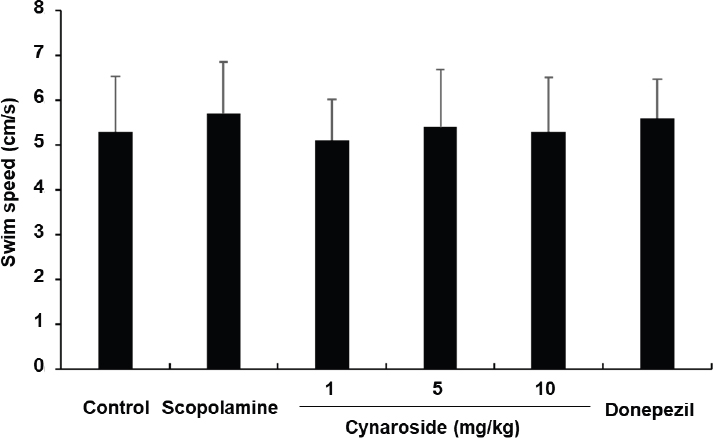
The effect of cynaroside on swim speed to find the platform over 4 days of scopolamine-treated mice in the Morris water maze test. Data are mean escape latencies ± SD (n = 6). (*p < 0.05, **p < 0.01 and ***p < 0.001 versus scopolamine-treated mice.)
The Morris water maze test was used to evaluate the protective effect of cynaroside against scopolamine-induced cognitive impairment.15 Scopolamine disrupts cholinergic signaling, leading to learning and memory deficits, and is known to increase AChE activity in the hippocampus.16 In this test, cynaroside was administered to assess its impact on escape latency, the time it takes for mice to locate the hidden platform. The results showed that cynaroside significantly reduced the escape latency induced by scopolamine in a dose-dependent manner, meaning that higher doses of cynaroside led to quicker platform location by the mice. The cynaroside-treated mice were able to find the platform faster compared to the scopolamine-treated group. However, there were no significant differences in the average swimming speed among the control, scopolamine-treated, and cynaroside-treated groups over the four-day testing period. This finding indicates that the observed reduction in escape latency in the cynaroside-treated mice was not due to an improvement in motor function but rather to enhanced memory performance. Additionally, the cynaroside-treated mice spent more time in the target quadrant where the platform was previously located, compared to the scopolamine-treated mice. This behavior suggests that cynaroside improved memory retention, as the mice were able to remember and recognize the location of the platform more effectively. In conclusion, the detailed results demonstrate that cynaroside effectively improves spatial memory and learning ability in mice, as evidenced by reduced escape latency and increased time spent in the target quadrant, without affecting their swimming speed. Cynaroside exhibited the most potent cognitive enhancing activity among the compounds isolated from L. christinae in the Morris water maze test.
The passive avoidance test is commonly used to assess long-term memory and evaluate memory enhancement.17 To examine the enduring memory improvement resulting from cynaroside treatment, a passive avoidance experiment was conducted using a mouse model with scopolamine-induced memory impairment. During the acquisition trial of the passive avoidance test, latency times were measured to determine how long it took for the mice to avoid an aversive stimulus. The results showed no significant differences in latency times among the various groups, indicating that the initial learning capabilities were comparable across all conditions. Specifically, the average latency times for the control group, scopolamine-treated group, and donepezil-treated group were 1.67 s, 1.49 s, and 1.96 s, respectively. For the cynaroside-treated groups, the average latency times were 1.56 s for the 1 mg/kg concentration, 1.87 s for the 5 mg/kg concentration, and 1.69 s for the 10 mg/kg concentration (Fig. 6). These results confirm that there were no significant variations in latency times among the groups during the acquisition phase, indicating that the experiment started with a uniform baseline for memory performance. This baseline comparability ensures that any observed differences in memory enhancement or impairment after treatment can be attributed to the effects of the treatments rather than pre-existing differences in learning capabilities.

The effect of cynaroside on scopolamine-induced memory impairment in the passive avoidance test. The latency prior to entry to the dark compartment was recorded. Data are mean latency times (s) ± SD (n = 6). (*p < 0.05, **p < 0.01 and ***p < 0.001 compared with the scopolamine treated group).
During the test trial, the latency time of the scopolamine-treated group was significantly shorter compared to the control group, demonstrating the effective induction of memory impairment by scopolamine. Specifically, the control group had an average latency time of 29.43 s, whereas the scopolamine-treated group had a reduced latency time of about 5.33 s. In contrast, the cynaroside-treated groups showed increased latency times in a dose-dependent manner, with average times of 13.45 s, 16.44 s, and 21.49 s for the 1 mg/kg, 5 mg/kg, and 10 mg/kg doses, respectively (Fig. 6). The passive avoidance test, which requires animals to learn to avoid an aversive stimulus such as an electric foot shock, was used to assess the potential of orally administered cynaroside to mitigate scopolamine-induced memory deficits and improve long-term potentiation. During the acquisition trial, latency times did not differ significantly among the groups, indicating similar initial learning conditions. However, in the test trial, cynaroside treatment led to a dose-dependent increase in mean latency times compared to the scopolamine-treated group. These findings suggest that cynaroside effectively enhances learning and helps restore memory impairment caused by scopolamine.
Cynaroside’s effect on AChE activity in the hippocampus was examined. Scopolamine increased AChE activity by 154.8% compared to the control group, while cynaroside significantly reduced AChE activity in a dose-dependent manner (p < 0.05). Specifically, AChE activity was reduced by 126.8%, 120.4%, and 111.8% with cynaroside at concentrations of 1 mg/kg, 5 mg/kg, and 10 mg/kg, respectively (Fig. 7).
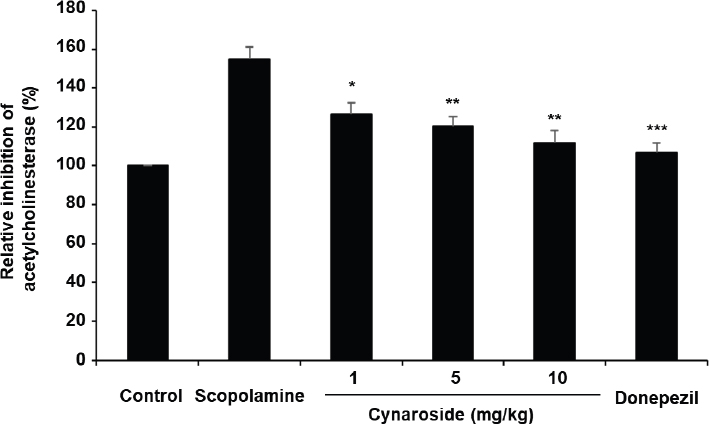
The effect of cynaroside on activity of acetylcholinesterase in the hippocampi of the scopolamine-treated mice. Data were means ± SD. *p < 0.05, **p < 0.01 and ***p < 0.001 compared with the scopolamine-treated group (𝑛 = 3).
To investigate how cynaroside improves memory, we thoroughly analyzed enzyme expressions and activities. Acetylcholine is critical for cognitive functions, including learning and memory, affecting both working memory and spatial memory. In diseases like Alzheimer’s, acetylcholine levels often decrease, contributing to cognitive decline. This decrease is associated with increased activity of acetylcholinesterase (AChE), an enzyme responsible for breaking down acetylcholine. Therefore, AChE has become a major target for Alzheimer’s treatments.18,19 Several AChE inhibitors, such as donepezil, galantamine, and tacrine, have been developed to address memory loss by preventing the breakdown of acetylcholine, thereby enhancing its levels and function.19,20 In our experiments, cynaroside demonstrated a dose-dependent inhibition of AChE activity. This means that cynaroside effectively reduced AChE activity in a concentration-dependent manner. Higher doses of cynaroside resulted in greater inhibition of AChE. These results suggest that cynaroside alleviates memory deficits induced by scopolamine by inhibiting AChE activity. By decreasing AChE activity, cynaroside helps to maintain higher levels of acetylcholine, which is essential for improving memory. Consequently, cynaroside may enhance cognitive function by increasing acetylcholine availability, thereby addressing memory impairments caused by scopolamine.
In conclusion, our study demonstrates that cynaroside, a compound isolated from the extract of L. christinae, effectively alleviates scopolamine-induced memory impairments in mice in a dose-dependent manner. This beneficial effect is likely mediated through the inhibition of acetylcholinesterase (AChE), an enzyme that degrades acetylcholine, a neurotransmitter essential for cognitive functions like learning and memory. By inhibiting AChE, cynaroside helps maintain higher levels of acetylcholine, which is crucial for improving memory and cognitive performance. These findings suggest that cynaroside could be a promising candidate for development as a botanical drug for preventing and treating neurodegenerative diseases, including Alzheimer’s disease. Given its mechanism of action and effectiveness in mitigating memory deficits, cynaroside may offer a novel therapeutic approach for addressing the cognitive impairments associated with such conditions.
Acknowledgments
This research was supported by Korea Basice Science Institute (National research Facilities and Equipment Center) grant funded by the Ministry of Education (grant No. 2022R1A6C101A739)
Conflicts of interest statement
The authors have declared that there are no conflicts of interest.
References
-
Giacobini, E. J. Neural. Transm. Suppl. 2002, 62, 181–187.
[https://doi.org/10.1007/978-3-7091-6139-5_17]

-
Giacobini, E. Neurochem. Res. 2003, 28, 515–522.
[https://doi.org/10.1023/A:1022869222652]

-
Braida, D.; Paladini, E.; Griffini, P.; Lamerti, M.; Maggi, A.; Sala, M. Eur. J. Pharmacol. 1996, 302, 13–20.
[https://doi.org/10.1016/0014-2999(96)00072-6]

-
Bejar, C.; Wang, R. H.; Weinstock, M. Eur. J. Pharmacol. 1999, 383, 231–240.
[https://doi.org/10.1016/S0014-2999(99)00643-3]

-
Dawson, G. R.; Bentley, G.; Draper, F.; Rycroft, W.; Iversen, S. D.; Pagella, P. G. Pharmacol. Biochem. Behav. 1991, 39, 865–871.
[https://doi.org/10.1016/0091-3057(91)90045-4]

-
Ohno, M.; Watanabe, S. Eur. J. Pharmacol. 1996, 318, 267–271.
[https://doi.org/10.1016/S0014-2999(96)00907-7]

-
Zhang, H. T.; O'Donnell, J. M. Psychopharmacology 2000, 150, 311–316.
[https://doi.org/10.1007/s002130000414]

-
Jones, R. W.; Wesnes, K. A.; Kirby, J. Ann. N.Y. Acad. Sci. 1991, 640, 241–244.
[https://doi.org/10.1111/j.1749-6632.1991.tb00226.x]

-
Wesnes, K. A.; Simpson, P. M.; White, L.; Pinker, S.; Jertz, G.; Murphy, M.; Siegfried, K. Ann. N.Y. Acad. Sci. 1991, 640, 268–271.
[https://doi.org/10.1111/j.1749-6632.1991.tb00231.x]

-
Beatty, W. W.; Butters, N.; Janowsky, D. S. Behav. Neural. Biol. 1986, 45, 196–211.
[https://doi.org/10.1016/S0163-1047(86)90772-7]

-
Ebert, U.; Kirch, W. Eur. J. Clin. Invest. 1998, 28, 944–949.
[https://doi.org/10.1046/j.1365-2362.1998.00393.x]

- Ryu, G.; Ma, C. J. Kor. J. Pharmacogn. 2023, 54, 9–15.
-
Ryu, G.; Ma, C. J. Nat. Prod. Sci. 2023, 29, 10–16.
[https://doi.org/10.20307/nps.2023.29.1.10]

-
Pohanka, M.; Jun, D.; Kuca, K. J. Enzyme Inhib. Med. Chem. 2008, 23, 781–784.
[https://doi.org/10.1080/14756360701811023]

-
Morris, R. J. Neurosci. Methods 1984, 11, 47–60.
[https://doi.org/10.1016/0165-0270(84)90007-4]

-
Stachenfeld, K. L.; Botvinick, M. M.; Gershman, S. J. Nat. Neurosci. 2017, 20, 1643–1653.
[https://doi.org/10.1038/nn.4650]

-
Lewis, P. R.; Shute, C. C.; Silver, A. J. Physiol. 1967, 191, 215–224.
[https://doi.org/10.1113/jphysiol.1967.sp008246]

-
Blokland, A. Brain Res. Brain Res. Rev. 1995, 21, 285–300.
[https://doi.org/10.1016/0165-0173(95)00016-X]

-
McGleenon, B. M.; Dynan, K. B.; Passmore, A. P. Br. J. Clin. Pharmacol. 1999, 48, 471–480.
[https://doi.org/10.1046/j.1365-2125.1999.00026.x]

-
Ballard, C. G. Eur. Neurol. 2002, 47, 64–70.
[https://doi.org/10.1159/000047952]

